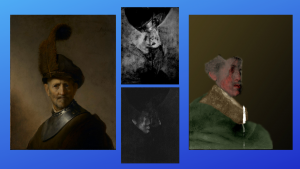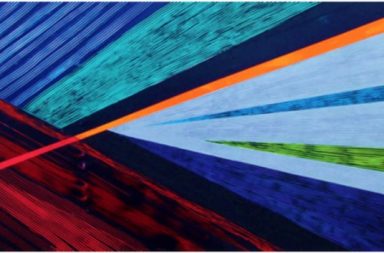Spectroscopic imaging techniques which have been used by scientists for decades to discover the secrets of the stars are now being turned to a more Earthly pursuit — revealing the secrets hidden beneath history’s masterpieces.
Since its inception at the very dawn of time, the study and simple appreciation of art has elicited questions such as what were the circumstances around its creation? What materials and techniques did the artist use? What ideas did they reject before embarking on this final piece?
A scientific technique previously deployed to stare beneath the surface of the stars and determine their composition, is being used to glimpse beneath the surface of historic and iconic pieces of art to seek an answer to these questions.
The pieces that it has thus far been turned towards range from ancient Egyptian paintings to 15th Century illustrated manuscripts to artwork from the Italian Renaissance.
One artist who has been the focus of much of this examination is Pablo Picasso, his Mother and Child by the Sea — painted during the artist’s ‘Blue Period’ — having the details hidden mere microns beneath its surface revealed by spectroscopic techniques.

Spectroscopic analysis of Picasso’s Mother Child by the Sea revealed newspaper and an image of a woman sipping absinthe.
The process also allowed researchers to determine the rough date the painting was produced after newsprint was discovered beneath its surface — placing its creation at around the 18th January 1902. The fact that Picasso seemingly had a habit of covering his canvas with newspapers was a revelation of itself, but it also explained some of the more unusual textures in the paint — a result of it not being applied directly to the canvas.
Researchers discovered also a portrait of a woman sipping absinthe lurking beneath the skin of the painting in addition to an upside-down signature — implying that there may well be another piece hidden beneath this. What is this technique that allows us to stare back into these artist’s creative processes and what other secrets could it reveal?
What are spectroscopic imaging techniques?
The groundwork of spectroscopic imaging was laid in 1704 — almost 200 years before the painting of Picasso’s Mother and Child by the Sea — when Sir Isaac Newton demonstrated the splitting white light into separate colours. This is because light is made up of a continuous spectra of different wavelengths.
Passing through a prism causes these different wavelengths to travel in different directions. In the case of many forms of light, this results in a multicoloured band — similar to a rainbow.
This basic discovery would be expanded upon in 1802 when William Hyde Wollaston built a basic spectrometer and projected an image of the Sun onto a screen — noticing that the spectrum of colours produced had noticeable gaps in it.
Building upon the work of these and many other scientists, German physicist Gustav Kirchhoff and chemist Robert Bunsen would discover in the 1860s that specific elements had characteristic gaps in their spectrums, meaning that they could be identified by their emission and absorption pattern. These two forms of line-spectra are a result of the different internal structure of the atoms of different elements.
It arises from the fact that electrons in atoms require the absorption of different amounts of energy to ‘jump’ to a higher energy state. Likewise, they have to emit different amounts of energy to ‘step-down’ to a lower state or the ground state. These leaps can only be caused by photons of that specific energy.
For example, it takes 11.2 eV to move an electron from its ground state to its first excited state in hydrogen. Two photons with energies of 5.6eV each won’t cause this jump. Only a photon of 11.2eV. So if we can spot a gap in the spectrum of light passing through a cloud of gas that corresponds to 11.2eV, it gives us a hint that some of that gas is hydrogen.
As energy corresponds to frequency and frequency is the inverse of wavelength, this means the emission and absorption of light at specific wavelengths — corresponding to different colours.
Following this discovery, the husband and wife team of William and Marget Huggins would use the newly developed technique to discover that the Sun was composed of the same elements as the Earth. Not only that, but advances in the technique have allowed us to ascertain our star’s chemical abundance, temperature density and pressure. Observations we have extended to distant objects.
Indeed, it was the observation of the broadening of spectral lines from distant objects and the application of the Doppler effect that taught us that the Universe is expanding and allowed us to calculate the rate at which that is occurring.
So how did we turn these principles and techniques to the more terrestrial, but no-less profound work of history’s finest artists?
Shining a light on art
Shining ambient light or additional visible light or paintings allows researchers to identify the materials used in their creation by analysing the spectra and heat emitted by paints and pigments.

Acquisition techniques for hyperspectral imaging, visualized as sections of the hyperspectral datacube with its two spatial dimensions (x,y) and one spectral dimension (lambda).
To go further than this, researchers mix spectroscopy with digital imaging techniques to form the basis of a method called hyperspectral imaging. This method builds a separate spectrum for each pixel in an image. It also examines wavelengths in the near-infrared section of the electromagnetic spectrum — invisible to the human eye. Some pigments and paints actually become transparent to radiation at greater wavelengths — thus meaning that hyperspectral imaging can often help us see details that would completely escape the human eye.
For each pixel, a 3D ‘image-cube’ is created showing the wavelengths of the spectrum which are represented and their distribution. This can then be compared to the spectra of materials used by an artist. This allows for a much less-qualitative way to view colour, as well as the ability to make very subtle distinctions between colour and hue.
The best thing about the method, of course, is that it is completely non-invasive and doesn’t require the collection of even a tiny fragment of the work of art to be examined.
But the visible spectrum and near-infrared only constitute a small part of the electromagnetic spectrum. To see the whole story of a piece of art, it may be required to expand our horizons even further.
Seeing the bigger picture — what is and what may have been
Whilst hyperspectral imaging is an extremely powerful investigation technique, its power to reveal the secrets of art are only truly accessed when combining it with other methods — particularly X-ray powder diffraction and X-ray fluorescence. The fusion of various methods ensures a more complete picture is visible.
X-ray fluorescence, in particular, allows researchers to penetrate beneath the surface of a painting — thus allowing researchers to almost travel through time and envision not just how a painting was created, but also what an artist may have created instead.

Rembrandt’s An Old Man in Military Costume and the portrait which lies beneath it, as revealed by the use of x-ray fluorescence
The most startling example of this comes from an examination into Rembrandt’s An Old Man in Military Costume — was first probed with x-rays in 1968 revealing a hidden figure beneath the titular character, rotated at 180 degrees.
In 2015, researchers at the Getty Conservation Institute and the Getty Museum, together with collaborators from the University of Antwerp and the Delft University of Technology, were able to use X-ray fluorescence to reconstruct this abandoned portrait in stunning detail.
What they captured was a man with brownish hair, a collar, and an olive cloak — very probably also painted by Rembrandt. What they could not recreate, however, was the exact reasons the artist abandoned this portrait to begin a new piece.
The future of investigating the past
John Delaney — one of the leading figures in this new area of science and the scientist behind the investigation into Picasso’s work — believes that the use of x-ray fluorescence marks the way forward in the examination of some of art’s finest masterpieces but isn’t limiting his work to these methodologies.
Delaney is also working on new ways to record spectrographic data. Whereas most cameras record just light, at their Washington lab, Delany and his collaborators are working on techniques that will record the thermal emissions of paintings stored in cool, dark chambers.
As Delaney works on this development, Haida Liang of Nottingham Trent University is developing methods that will be able to process images taken from whole walls. It is hoped this will suitable to apply to caves — such as the Mogao caves at the edge of the Gobi Desert in China, the outside of buildings and even amassed collections of paintings.
As these techniques and the technologies upon which we built them advance we stand to learn much more about the artistic endeavours of the past, discovering great masterpieces that could have been. It is the closest we may come to knowing these great artists and the times in which they lived.
If you liked this article, you can invite the author to a coffee or whatever you want. Thanks to your contribution we will be able to continue offering the latest news about contemporary art in connection with science and technology.


